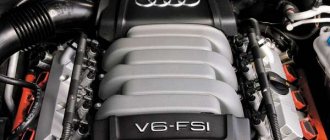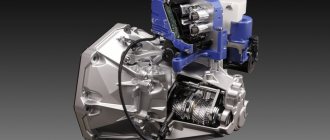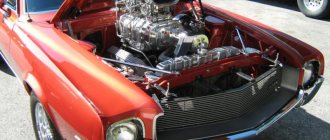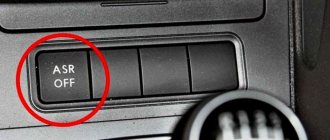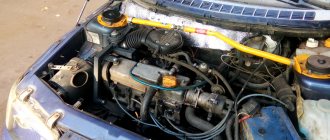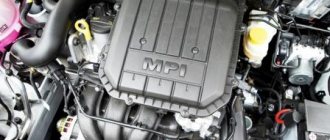5
(2)
How the VTEC system works: location and types VTEC system - The Variable Valve Timing and Lift Electronic Control, an electronically controlled valve phasing system, its presence is determined by the engine model, namely the cylinder head model, oil supply solenoids and ECU engine control unit with distributed injection. The bottom image shows the location on the cylinder head where the VTEC solenoids are located, responsible for activating the long stroke rocker. The second image shows where the VTEC is located - the barrel of the solenoid indicates that the engine has VTEC. There are varieties of single-shaft SOHC VTEC system; unfortunately, the second DOHC VTEC system was not installed on D-series engines D14, D15, D16. VTEC solenoid valve resistance is 14-30 ohms, at 12 volts.
View of the solenoid of a two-stage VTEC system
Location of the solenoid on the cylinder head block of the Honda Civic
What is VTEC, how does VTEC work, the meaning of the system
Simply put, valve timing electronically controlled, or simply VTEC. It’s enough to understand a couple of basics for what it’s needed and everything will fall into place. An ordinary 4-stroke engine draws air from the atmosphere at a pressure of 1 bar, that is, approximately 760 mmHg (This is also 1 atmosphere or 101 kPa). As the revolutions increase, the speed of the piston also increases. At low speeds, the piston sucks in air as cleanly as possible, that is, the piston slowly lowering sucks in the volume with a pressure of 1 atmosphere. As the piston speed increases, the pressure decreases, because there is no longer enough time for the air to be under normal conditions. You've probably seen dyno graphs where peak power is around 5000-6000 rpm, and then the power line drops off. This is because the engine cannot suck in any more air, it is so rarefied (that is, there are few air molecules) that it becomes difficult to spin the engine. There are many possible solutions, remove air resistance by installing a zero filter, cold intake, increasing the throttle diameter, porting the intake channels or pumping air under pressure. But Honda came up with its own way. When the critical point of engine power is reached (approximately 5500 rpm), the VTEC system on the intake valves is activated, which keeps the valves open a little longer than usual, which gives additional time to “suck in” air. now the dead center shifts to the range of 7000. Any work with an intake system such as porting gives an increase in power at the top but can take away points for traction at the bottom, since the torque also shifts to higher speeds, to which you still need to rev the engine, there is very little air a lot of. what to do? choke the engine at low end, reduce air flow by approximately reducing the diameter of the throttle valve. You've probably heard that an 8-valve engine has more low-end potential than a 16-valve engine. This is the same thing. Honda engineers came up with the ECO-VTEC system, the principle of which not only saves fuel but also “strangles” the engine up to 2500 rpm (approximately) in order to extract maximum thrust, with only 12 valves operating.
In total, it turns out that with full VTEC 3-Stage, the bottoms are strangled and have a good torque, then work in the normal 16-valve mode, and activation at high speeds is already VTEC so that more air gets in. That's all you need to know from the basics of VTEC.
Honda VTEC engines: features, characteristics, pros and cons
Almost every car enthusiast at least once in his life has encountered symbols under the hood of a particular car in the form of abbreviations - VTEC or I-VTEC. But not every car lover knows what this marking means. The abbreviated concept VTEC stands for “Variable Valve Timing and Lift Electronic Control,” which translates as an electronic system for changing valve timing and valve lift in a power plant. The main purpose of the electronic valve timing control system is to optimize the passage of the fuel-air mixture into the engine combustion chambers.
We recommend that you read the article: Honest review of the Nissan Qashqai J11 2021
For the first time, an electronic system for changing valve timing appeared in 1989 and, having reached our time, has already been seriously improved 2 times. Therefore, today we can see the 3rd generation of the system on some new machines. VTEC technology itself uses the capabilities of electronics and mechanics in its work, which allows the power plant to very effectively manage the capabilities of two camshafts simultaneously, and in simplified SOHC engines - one camshaft. The system controls the speed of the engine with the ranges in such a way that the car's computer can activate and connect additional cams to work. This is done in order to select the most optimal operating mode.
1. PRINCIPLE OF OPERATION AND CONSTRUCTION OF MOTORS WITH VTEC SYSTEM
The main feature of engines with the VTEC system in comparison with traditional power plants is the achievement of maximum torque at lower speeds. If we take the characteristics of different engines, we can clearly see that for some the maximum torque is achieved at lower speeds in the range from 1800 to 3000, and for others at higher speeds, for example in the range from 3500 to 4500 rpm.
The above-described points in the difference in the achievement of maximum engine speeds are explained by the fact that in the case of more efficient filling of the combustion chambers of the cylinders with fuel, it makes it possible to obtain high torque at low speeds. In addition, obtaining high torque at certain speeds also depends on the design of the exhaust tract and certain settings of the car’s gas distribution mechanism. In other words, the efficiency of the power plant is directly determined by the valve timing. For reference, we note that these phases are formed due to the special profile of the camshaft cams.
To imagine in more detail the principle of operation of an engine with a VTEC system, let’s take for example an internal combustion engine that operates at 20 rpm, that is, the intake and exhaust valves of the installation are activated 10 times per minute, that is, quite rarely. To extract the maximum torque at such speeds, the intake valve must open almost at the beginning of the suction stroke, that is, when the piston begins its movement from top dead center, and then closes at the moment the piston returns to bottom dead center. The exhaust valve operates according to exactly the same scheme, that is, there should be no delays with advances in the operation of the valve mechanism, otherwise the torque will decrease.
It is precisely with the entire operating algorithm described above that the combustion chambers of the cylinders are optimally filled with the fuel-air mixture and the effect from the engine operation is the highest. This is the scenario in which an engine with a VTEC system operates.
The figures that we cited above as an example are a sham; in reality, the engine speed can increase to 3500-4000 rpm and the intake and exhaust valves in this embodiment open and then close at 1800-2000 times per minute or approximately 30-35 times in 1 second, which is considered quite often. With this mode of engine operation, there is very little time left for the piston to absorb a new portion of charge.
That is why, only at the moment when the piston of the power plant reaches bottom dead center, the fuel supply speed, and therefore its flow rate through the flow area of the exhaust valves, reach maximum values. At this moment, the intake valve closes and the bulk of the portion of fresh fuel can no longer penetrate the combustion chambers, since it simply bumps into the closed valve, which slams prematurely. In this case, the engine begins to stall, as a result of which the power temporarily decreases slightly and the maximum speed decreases. This whole operating pattern is the merit of the valve timing of the VTEC system.
For reference, we note that the latest 3rd generation of engines working in tandem with the VTEC system have average valve timing adjustments, which are designed for different occasions. Average valve timing settings are obtained thanks to a special profile of the camshaft cams. In addition, designers and engineers have refined the system to such an extent that in order for the engine to function under optimal conditions at different speeds, a special gas distribution mechanism was designed.
In such a system, the camshaft is equipped with different cams for both low and high engine crankshaft speeds. Due to this, different torques are achieved for opening and closing the cams, and high power is generated at high speeds of the power plant.
2. WHAT ENGINES ARE EQUIPPED WITH VTEC? FEATURES AND GENERATIONS OF VTEC SYSTEMS
The first engine that began to work with VTEC technology was an engine with a SOHC system, which has a single camshaft in the gas distribution mechanism and is used only for intake valves. The efficiency of this engine and VTEC system is marginally lower than DOHC VTEC. However, the design and maintainability are much simpler, which also affected the compact dimensions and weight of the power plant.
Over time, the SOHC engine began to be equipped with an improved VTEC-E system, which is capable of maximally reducing fuel consumption, which in turn improves environmental performance. At low speeds, such an engine operates on a lean mixture, which enters the cylinder chambers only through one single intake valve. When the fuel-air mixture enters the chambers, it swirls and ensures its stable combustion. If the engine speed increases, the VTEC-E system is automatically activated, which immediately blocks the intake and exhaust valves. After which the joint work of the motor and the economical system begins.
Then, after a certain amount of time, Japanese engineers from the Honda company, on whose cars the VTEC system is mainly installed, developed a SOHC 3-stage gas distribution mechanism. Paired with this engine, VTEC technology began to operate. The SOHC 3-stage power plant has 3 operating modes, unlike the conventional SOHC, which has only 2 modes. Note that in the low speed zone, the VTEC system in tandem with such an engine provides an economical mode of operation of the engine on a lean mixture and in this case only one single intake valve is used.
At medium speeds, the 2nd valve is activated, but the valve timing and valve lift do not change. In addition, in this operating algorithm, the power plant achieves high torque. As for the high speed mode, there are two valves controlled by the 1st central cam, which is responsible for extracting maximum power from the engine.
After which a power plant with 2 camshafts and known to almost every car enthusiast for its DOHC marking was born. This engine also began to be actively used by Honda for its cars in conjunction with VTEC technology. The foundation for the design of such a motor was the 4-valve gas distribution mechanism widely used in the automotive industry. DOHC VTEC engines have a special device in the form of a separate camshaft for each bank of valves, both intake and exhaust.
The next feature of the engine is that for every 2 valves there are 3 cams located on the camshaft. Two side cams are needed for the operation of the power plant in the event of low and medium speeds, and the central one is necessary for high speeds. The influence of the cams on the valves is carried out using a rocker, of which there are also 3 units per 2 valves.
In addition, the rockers are equipped with hydraulically controlled small pistons, the task of which is to move and connect the mechanism into one whole when a certain impact appears on them. As for the middle rocker, it is configured with a special spring. This spring ensures systematic contact of the cam with the rocker at low as well as medium speeds.
For reference, note that when the DOHC VTEC powerplant operates at low speeds, the rockers are in an unlocked state and each of them produces independent movement that corresponds to the trajectory of the cam. As for the middle cam, it rotates with the other components, but does not take part in the operation of the gas distribution mechanism.
After the engine switches to high speed mode, the electronic car computer gives a command to its execution unit to increase oil pressure in order to set in motion the small pistons of the system, which are located in the rockers to move them. This in turn leads to complete blocking of the rockers. What is all this for? The fact is that after such simple actions, all elements of the above group will become completely controlled by the central cam. Thanks to this, the central cam will now independently control the operation of two system valves at once.
The next technology that began to be equipped with engines with a mechanism for changing valve timing and valve lift was the VTC system, which continuously began to regulate the moment when the intake valves began to open. This device design was called i-VTEC and was based on the time-tested DOHS engine (DOHS i-VTEC). In power plants equipped with such a system, the opening phases of the intake valves are set depending on the engine load and are adjusted by changing the angle of the intake camshaft relative to the exhaust.
Based on the opinions of experts, the use of the VTEC system makes it possible to more efficiently fill the combustion chambers of the cylinders with the fuel-air mixture. This, in turn, is reflected in an increase in the final power of the motor, which increases by an average of 20-25 percent, and torque by about 10-15 percent. In addition, thanks to such a system, fuel consumption is optimized and further reduced, on average by 15-20 percent, which is quite a significant saving.
In conclusion, we note that the engines described above in combination with VTEC technology, in principle, do not represent eternal or supernatural engines, but the effect they give during operation is simply surprising. VTEC powerplants are the main ones for Japanese Honda cars and they are excellent at adapting to different loads, delivering optimal power from a small displacement. In addition, as we said earlier, such engines never cease to amaze with their efficiency, especially at idle and low speed.
SOURCE OF MATERIAL - OUR YANDEX ZEN CHANNEL
Working principle of VTEC
I will show you the example of the most famous and simple animation image that explains the principle of operation of VTEC. When the oil pressure in the engine is reached, as well as the speed is reached, usually 5500 RPM, the VTEC valve opens due to the solenoid, which supplies oil to the gas distribution system.
Animated demonstration of part of the VTEC system operation
Oil pressure pushes the “latches” of the rockers, which lock the main and middle rockers. Now the valves open deeper - longer. At the same moment, the fuel and ignition maps are switched in the engine control unit (ECU). Due to the richer mixture and longer opening of the valves, a more powerful impulse appears to push the piston.
Operating principle of VTEC rocker activation
VTEC Valve Opening Duration As you understand, the duration of VTEC valve opening depends on the engine RPM. At approximately 5500 rpm, VTEC turns on, at 4600 (approximately) VTEC turns off. On an automatic transmission up to 4th gear, the activation of VTEC takes no more than 5 seconds, the system is automated and, when the revolutions and speed are reached, it switches gears, which means it resets the RPM. In terms of operating time of the VTEC system, this is only a few seconds, but it is they that give the real gain. Vtek does not turn on in netralka, and in parking mode in automatic and varator.
General concept
To understand what VTEC is, let's look at the differences between regular and sports camshafts. Structurally, both shafts are the same, but the latter has a higher cam height than the usual one, and its geometry is smoother. Due to this cam shape, sports camshafts provide better cylinder filling due to increased valve opening time and height.
VTEC combines the design features of simple and sports camshafts, which allows you to automatically adjust the valve timing depending on the operating conditions of the engine. At low speeds, the system uses cams with a regular geometry, therefore saving fuel, and at high speeds, with an increased height, providing maximum power output.
VTEC 3-Stage: what is it?
Finally, I will talk about the VTEC 3-Stage system (stage 3). This system is also installed in the cylinder head; it was installed after 1996. Has 2 solenoids. It is controlled by 12 volts; when supplied, the oil supply valve opens, if there is, of course, oil pressure. It was installed on a JDM motor D15B, single-shaft SOHC, and of course not a B series. The thing is quite interesting and in demand. It has 3 stages, combines all operating modes of all types of SOHC D series. There were several types of ECUs, but only OBD2 series, below is a list of all p2j 3-Stage ECUs
- OBD2A 37820-P2J-J62 CVT
- OBD2A 37820-P2J-J63 CVT
- OBD2A 37820-P2J-J61 CVT
- OBD2A 37820-P2J-003 Mechanics
- OBD2B 37820-P2J-J11 Mechanical
- OBD2B 37820-P2J-J81 CVT from Vi-RS
- OBD2B 37820-P2J-J71 CVT
Design features
Let's look at what VTEC is on a Honda using the example of an engine with a DOHC timing system, since it was first used on this engine and is structurally the simplest. The peculiarity of this gas distribution mechanism is the use of 4 valves for each cylinder (a pair of intake and exhaust, operating synchronously) and two camshafts, each of which is responsible for opening its own valves.
Operating principle of VTEC rocker activation
VTEC rocker switch off
VTEC on this engine has two operating modes and involves the use of three cams per pair of valves (both intake and exhaust), instead of two. The third cam has an increased height and smooth geometry (repeats the shape of a sports camshaft cam) and is placed between two regular ones.
The outer cams (with the usual shape) act on the valves not directly, but through rockers, rocker arms, and pushers (depending on the timing mechanism design). The central cam also has a rocker (rocker arm), but they do not have any effect on the valves. But an oil channel is made in them and retractable pins are installed, which, entering special recesses of the outer rockers (rods), connect the rockers to each other and ensure their synchronous movement.
The oil channel made in the rocker axles and the central rocker is equipped with a solenoid valve controlled by the engine ECU, which allows you to control the flow of oil that is supplied to the VTEC.
VTEC 3-Stage: operating principle
How VTEC 3-Stage works, the first stage starts at 0 RPM and ends at 4000 RPM. at this stage the cylinder head operates as VTEC-E. Only 12 valves work. Each cylinder has two exhaust valves but only one intake valve. This allows for economical and smooth acceleration. The next stage is the operation of all 16 valves. The first VTEC solenoid turns on. Normal mode, runs from 4000 to 6000 The last third stage, the second valve is turned on, the intake valves open for a longer period, which allows for more fuel mixture. Work from 6000 to the end point of work The entire system is turned off in the reverse order, first the 2nd solenoid, then 1 solenoid.
Time to get to work
Now that you know how VTEC works, it’s time to install it on your D14A3 or D14A4, I suggest using the translation of the DoDo Joris article that I used, or using my article on installing VTEC. However, good luck with your experiments.
How useful is the publication?
Click on a star to rate!
Average rating 5 / 5. Number of ratings: 2
No ratings yet. Be the first to rate.
Ten excellent VTEC engines
If you are thinking about getting your first Honda for a project, or thinking about an engine for a swap, then this list will be interesting
B16A
Where installed: 1989-1993 JDM Integra XSi, RSi; 1989-1991 Civic CRX SiR
Power/Torque: 160hp/152N.m.
Why it's great: The first DOHC VTEC you can afford.
B16B Type R
Where installed: 1997-2000 JDM Civic Type R
Power/Torque: 185hp/160N.m.
Why it’s good: The B18C version with a reduced piston stroke, holds high speeds well.
B18C1
Where installed: 1994-2001 Integra GS-R
Power/Torque: 170hp/173N.m.
What's good: The first 1.8 VTEC, with a two-stage intake manifold.
B18C Type R
Where installed: 1995-2001 JDM Integra Type R
Power/Torque: 200hp/185N.m.
What's good: The most powerful of the B-series
C32B Type R
Where they installed: 2002-2005 JDM NSX-R
Power/Torque: 290hp/303N.m.
What's Good: A meticulously balanced version of the standard NSX engine. Incredibly expensive, can't be found.
F20C1
Where they installed: 2000-2005 S2000
Power/Torque: 240hp/207N.m.
Why it's good: Considered the most productive four-cylinder engine, it revs well without sacrificing average revs.
H22A1
Where installed: 1993-1996 Prelude VTEC
Power/Torque: 190hp/214N.m.
What's good: Honda's first big block. Behind him are drag records and the history of the brand.
J37A4
Where they installed: 2009-2013 TL SH-AWD
Power/Torque: 305hp/370N.m.
What's good: The most powerful Honda engine to date
K20A Type R
Where they installed: 01-05 Civic, Integra Type R
Power/Torque: 212 hp/202 N.m.
What's good: Top K-series engine, option for swappers
VTC
VTC is that additional component that turns DOHC VTEC into the new “DOHC i-VTEC” and “VTEC-E” into “DOHC i-VTEC I”. This is a mechanism that rotates the intake camshaft relative to the exhaust camshaft using oil pressure.
The abbreviation VTC stands for Variable Timing Control, which translated means “Variable Valve Timing System”. In fact, the decoding of the name has the same meaning as VTEC. In principle, the goal of these systems is the same, but each does it differently and at the same time complements each other. An additional VTC system is installed and only affects the intake camshaft.
At high speeds, the time for opening and closing the valves is much less, although more fuel-air mixture needs to be supplied. Therefore, it is necessary to increase the opening phase and valve lift height, which is what VTEC does, and the VTC system “creates favorable conditions” for the effective operation of VTEC.
If the VTEC system, with the help of an additional cam, allows you to drive the valves deeper and slightly increases the open time, then VTC makes it possible to tighten the camshaft so that the valves open earlier, which contributes to more efficient ventilation of the cylinders.
Unlike the main VTEC system, which is activated at a certain speed range, the additional VTC system operates constantly and continuously, adjusting the opening timing of the intake valves depending on the engine load. Let's figure out how she does it.
Conclusion
Without going into the details of the design of engines with DOHC i-VTEC, we can say that the essence of the topic is revealed in this article. In fact, the new DOHC i-VTEC in both its forms is the good old VTEC supplemented with the new intelligent VTC feature. And it is precisely due to VTC that engines with DOHC i-VTEC (both subtypes) began to work much more elastically than engines with first-generation VTEC and have more traction at the bottom.
Undoubtedly, the new engines are more productive, more technologically advanced and better, but the new VTEC has lost something - due to the acquired qualities, the inclusion of VTEC, which was such a “turn on”, has become almost unnoticeable. And yet DOHC i-VTEC is impressive... “drives” and “turns”.
Varieties of DOHC i-VTEC
DOHC i-VTEC DOHC VTEC + VTC
DOHC i-VTEC I SOHC VTEC-E + VTC + non-Vtec exhaust camshaft
| System | Type VTEC | VTC |
| DOHC i-VTEC | VTEC on intake and exhaust. VTEC response torque is 5800 rpm. | on the intake camshaft |
| DOHC i-VTEC I | VTEC-E on the intake, standard exhaust camshaft. VTEC response torque is 2500 rpm. | on the intake camshaft |
By and large, the prefix “i” in system names implies that VTC works in conjunction with the VTEC system. But before we figure out what VTC is, let’s remember the operating principle of traditional VTEC and VTEC-E, since DOHC i-VTEC in both of its manifestations is based precisely on the operating principles of the first generation VTEC.
